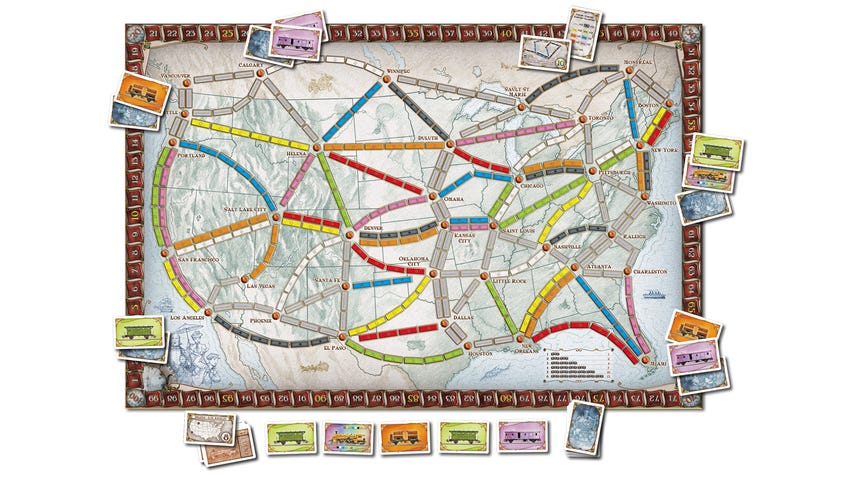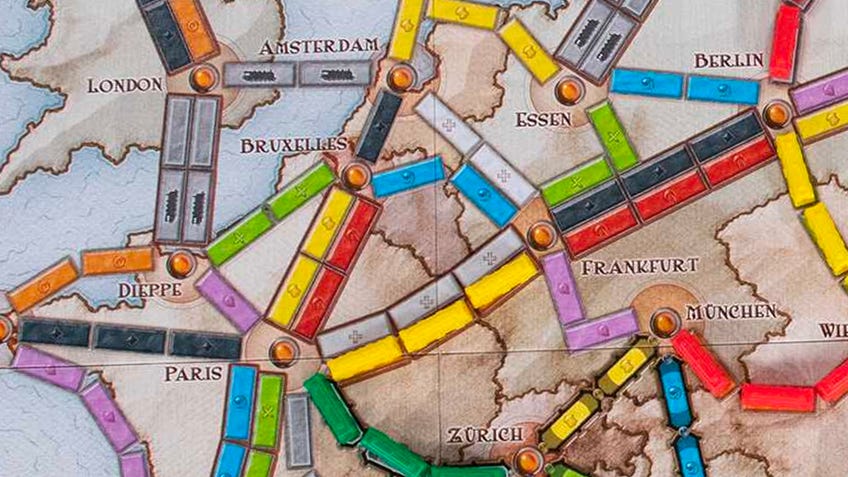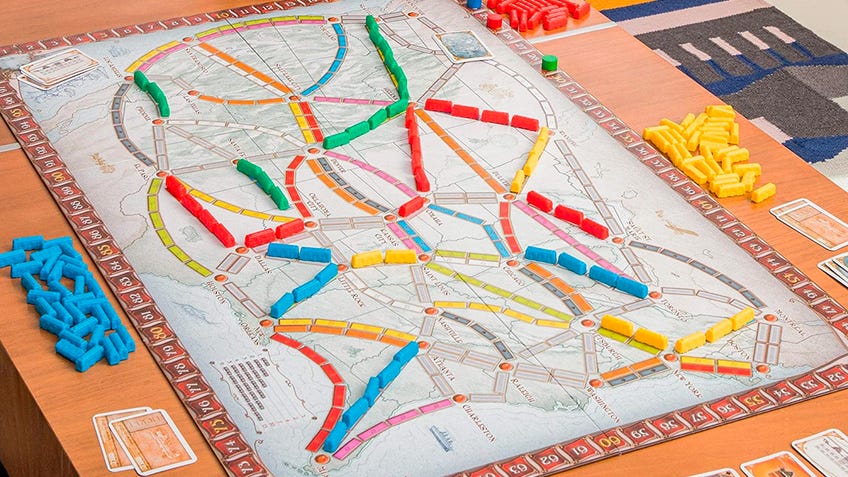How to play Ticket to Ride: rules, setup and how to win explained
Get on board with the classic train game.
Ticket to Ride is one of the most popular modern board games of this century. Since its release in 2004, Alan R. Moon’s beloved train game of cross-country competition has sold millions of copies, inspired numerous expansions and spin-offs set in different regions across the globe, and become a firm favourite for countless players. Whether you’re setting off on your first journey or are a regular traveller looking to refresh your familiarity with its rules, this beginner’s guide is the best place to learn how to play Ticket to Ride.
Ticket to Ride is fairly easy to learn how to play if you’re a newcomer. Players take turns doing one of just three different things on their turn - drawing train cards, claiming a route or drawing new destination tickets - in order to help fulfil their destination tickets and score points. While Ticket to Ride can be learnt in just a few minutes, the board game’s head-to-head race to claim routes before your opponents offers hours of competition and fun.
How to play Ticket to Ride
- Number of players, game length and overview
- How to set up Ticket to Ride
- Ticket to Ride rules
- How to win Ticket to Ride
Once you know how to play the original Ticket to Ride, which sees players travelling across North America, you’ll be able to quickly pick up its many spin-offs and expansions exploring countries and continents from Europe to India. While other Ticket to Ride games offer new rules and gameplay ideas, they all build on the basic Ticket to Ride rules, letting you ride full steam ahead wherever the series takes you.
So consider this guide your express ticket to a first-class board game adventure, as we teach you how to play Ticket to Ride. All aboard!
Ticket to Ride: Number of players, game length and overview
In Ticket to Ride, players are competing to claim train routes between major cities on the board. In standard Ticket to Ride, the map depicts North America in the early 20th century. By claiming routes and completing their hidden destination tickets, players earn victory points that decide the game’s final winner.
Ticket to Ride can be played by two to five players, with the board game recommended for players aged eight and up.
Ticket to Ride takes between 30 minutes and one hour to play, but the game’s length may vary based on the number of players and how familiar they are with the rules.
How to set up Ticket to Ride
- Put the main game board in the middle of the table.
- Give each player 45 train car pieces in their player colour. (Be sure to count the exact number of cars, as there are a handful of replacements included in the box!)
- Place a scoring marker for each player on the zero/100 space of the scoring track around the outside of the board.
- Shuffle the deck of train cards and deal four cards to each player. This is their starting hand.
- Place the remaining deck of train cards next to the board and draw the top five cards face-up into a row.
- Put the Longest Continuous Path card next to the board.
- Shuffle the deck of destination ticket cards. Deal three to each player. Each player must keep at least two of their tickets of their choice, but can choose to keep all three. Any discarded tickets are returned to the bottom of the deck.
- Place the destination ticket card deck next to the board.
- You’re ready to play Ticket to Ride! The official rules suggest that the most well-travelled player goes first; otherwise, choose randomly.
Ticket to Ride contents: What’s in the box?
Listed below are the standard contents of the original Ticket to Ride; other editions may include similar but different components. Some copies may also include additional promotional cards and materials.
- Game board, showing a map of North America
- 240 train cars (45 in each player colour: blue, red, green, yellow and black, plus some spares)
- 110 train car cards (12 in each of eight colours - pink, white, blue, yellow, orange, black, red and green - plus 14 wild rainbow-coloured locomotives)
- 30 destination ticket cards
- Longest Continuous Path bonus scoring card
- Five wooden scoring markers, one in each player colour
- Scoring reference card
- Rulebook

Ticket to Ride rules
On their turn, a player can do one of three different actions:
- Draw train cards
- Claim a route
- Draw destination tickets
Drawing train cards
When a player draws train cards, they may draw up to two tickets from the face-up row of train cards and/or the top of the train card deck (without seeing what it is first!)
If a face-up card is drawn from the row of cards, it is immediately replaced with the top card of the deck. If there are ever three rainbow-coloured wild locomotive cards in the row, the entire row must be immediately discarded and a fresh row of five cards drawn.
A player can choose to draw both cards from the row or the top of the deck, or one from each, in any order. If they claim a wild locomotive card from the face-up row, it must be the first and only card they claim that turn. However, if they draw a locomotive from the top of the deck, they may still claim a second card (except a face-up locomotive from the row).
If the deck runs out, simply reshuffle the discard pile to continue drawing. Players can have any number of cards in their hand.
Claiming a route
To claim a route on the board, players discard cards from their hand matching the number and colour of spaces between two locations on the map. Rainbow-coloured locomotive cards count as wild cards and can replace cards of any other colour. Grey spaces can be claimed with a set of cards in any colour, but those cards must all be matching (or wild locomotives). Once you’ve discarded the required cards, claim the route by placing your train cars on the spaces.
Players must claim an entire route between two cities as their action; you can’t claim partial routes. If another player has already claimed a route, you cannot claim the same route. Some routes are double-routes with two parallel tracks; in four- and five-player games, each route may be claimed by a different player. In two- and three-player games, only one track may be claimed.
When a player claims a route, they immediately score a number of victory points depending on the length of the route (count the number of car spaces):
- One car: 1 point
- Two cars: 2 points
- Three cars: 4 points
- Four cars: 7 points
- Five cars: 10 points
- Six cars: 15 points
Drawing destination tickets
On their turn, players can draw new destination tickets from the destination tickets deck. A player’s destination tickets are kept secret until the end of the game, at which point they are scored.
Any completed destination tickets - where the named cities are connected with an unbroken line of routes in the player’s colour - score the number of points stated on the card. Claimed routes can count towards multiple destination tickets. Any tickets left uncompleted deduct that number of points from the player’s final score.
Players can draw new destination tickets on any of their turns. To acquire new destination tickets, they draw three cards from the top of the top of the destination ticket deck. They must keep at least one of the cards drawn, but may choose to keep two or all three of the cards. Any unwanted cards are discarded to the bottom of the deck. There is no limit to the number of destination tickets a player can have.

How to win Ticket to Ride
To win Ticket to Ride, you must collect the most victory points by the end of the game. The end of the game is triggered when a player has two or fewer trains left in their supply at the end of their turn; the game concludes after every player, including the player who triggered the end of the game, takes one final turn.
In the case of a tiebreaker after scoring, the player who has completed the most destination tickets wins. If players are also tied on the number of completed destination tickets, the player with the Longest Continuous Path card wins.
Ticket to Ride scoring explained
Victory points are earned by claiming routes on the board - the number of points depends on the length of the route - completing routes on your destination tickets and having the Longest Continuous Path of train cars at the end of the game.
Points for claiming routes are scored immediately; each player’s destination tickets are kept secret and only scored at the end of the game. Any destination tickets that were not successfully completed are worth negative points, deducted from a player’s final score.
How does the Longest Route bonus work in Ticket to Ride?
The Longest Continuous Path in Ticket to Ride is awarded to the player with the longest unbroken chain of cars in their colour on the board at the end of the game.
Loops can be counted and the route can pass through the same city multiple times, but no individual train car can be counted twice. The Longest Continuous Path card is worth 10 bonus victory points, as stated on its reference card. (Put it next to the board so you remember!)
Can you play Ticket to Ride with two people?
Yes, you can play Ticket to Ride with two people. The board game’s official player count supports from two players up to five players.
To play Ticket to Ride with two people, follow the standard rules as explained above. There is only one notable rule difference for smaller groups: when playing with two or three people, only one person ever may claim each of the double-routes on the board. (The other track must be left empty.)

